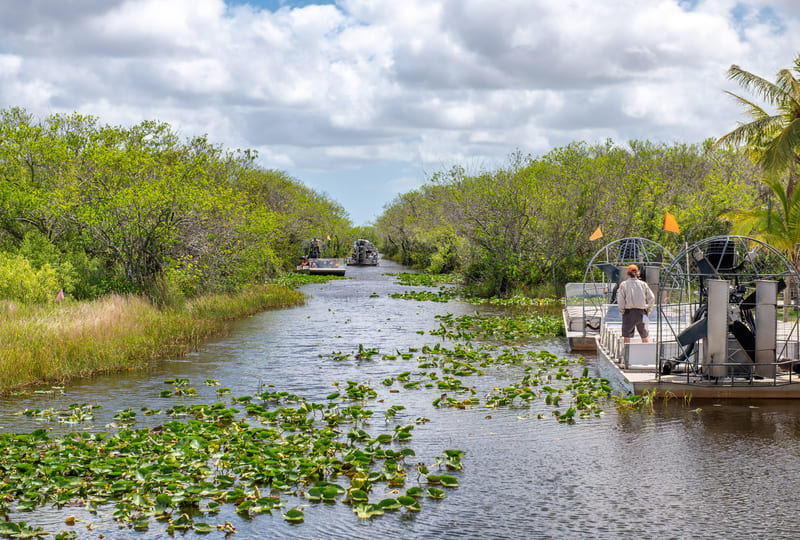Unveiling the Everglades: What Makes This Ecosystem an American Treasure
The Florida Everglades is one of America’s most distinctive and beautiful natural landscapes. Spanning over 7,800 square miles, this unique ecosystem is home to rare and diverse wildlife, sweeping landscapes, and an essential freshwater filtration system that serves millions of people. Known as the “River of Grass,” the Everglades is a vast, subtropical wilderness that has been a haven for nature lovers, wildlife enthusiasts, and conservationists alike. Below, we’ll uncover what makes the Everglades so special—and why it’s not only a natural wonder but a national treasure worth protecting and experiencing.
The Origins of the Everglades: A Legacy of Preservation
The Everglades is an ancient ecosystem that began forming thousands of years ago. This land, long inhabited by indigenous tribes such as the Miccosukee and Seminole, has supported life for centuries. During the early 20th century, the Everglades faced significant transformations as settlers sought to develop the land, resulting in draining projects that altered much of the landscape. However, the growing recognition of its ecological importance led to the establishment of Everglades National Park in 1947, safeguarding 1.5 million acres for future generations and preserving an ecosystem that has since become emblematic of American natural heritage. Today, you can learn more about the rich history and culture of the Everglades at the Everglades National Park website.
The “River of Grass”: A Unique Flowing Ecosystem
The Everglades is often called the “River of Grass” because it’s essentially a slow-moving river that flows from Lake Okeechobee to Florida Bay. This vast, shallow river flows at a leisurely quarter-mile per day, creating marshlands covered in sawgrass that flood during the rainy season. These waterlogged plains form the heart of the Everglades, supporting various species and providing vital water filtration for South Florida. The nickname reflects this unique hydrology, where water flows across grassy fields instead of between typical riverbanks, establishing a one-of-a-kind environment of interconnected waterways and grasslands. For more on why the Everglades is so unique, check out the Everglades overview at Everglades Holiday Park.
Wildlife Wonderland: A Sanctuary for Rare Species
The Everglades is a haven for some of the most iconic and endangered wildlife species in North America. With over 300 fish species, 360 bird species, and countless reptiles and mammals, the Everglades is a biodiversity hotspot.
Alligators and Crocodiles: Coexistence in the Wild
The Everglades is one of the few places on Earth where American alligators and crocodiles share the same habitat. These reptiles, each with distinct features, play crucial roles in the ecosystem. Alligators, for instance, create “gator holes” that retain water during the dry season, providing vital habitats for other animals. Crocodiles, which prefer saltier waters, are typically seen along coastal areas and are less common, adding a layer of rarity to the Everglades’ wildlife diversity.
The Florida Panther: An Elusive Predator
Perhaps the most famous resident of the Everglades is the endangered Florida panther. This big cat is a critical part of the ecosystem, as it helps control the populations of prey species. With only around 100 panthers left in the wild, this elusive predator’s future is uncertain, and conservation efforts are crucial. These efforts can be challenging, but projects like the Comprehensive Everglades Restoration Plan (CERP) aim to improve conditions for these rare creatures. Learn more about the work being done to protect the Everglades’ diverse wildlife at the National Wildlife Federation’s blog.
The Everglades: Florida’s Natural Water Filtration System
Beyond its ecological beauty, the Everglades serves as a vital water source for nearly eight million Floridians. The sawgrass and other plant life naturally filter pollutants from the water as it flows southward, recharging the Biscayne Aquifer, South Florida’s primary source of drinking water. This natural filtration process is critical in an area where water quality can be easily compromised by agricultural runoff, urban development, and pollution. By slowing the flow of water, the Everglades functions as a natural reservoir, mitigating the effects of droughts and floods and ensuring fresh water reaches communities across South Florida.
Habitats of the Everglades: A Tapestry of Ecosystems
The Everglades is not a single, uniform landscape. Instead, it’s a rich tapestry of ecosystems, each supporting a different range of species and contributing to the overall health of the environment.
Mangrove Forests
Mangroves, found along the coastlines of the Everglades, act as natural barriers against storm surges and provide nurseries for various fish species. Their dense root systems stabilize the shoreline, prevent erosion, and create rich habitats for marine life. Mangroves support creatures ranging from tiny crustaceans to wading birds, making them an essential part of the Everglades ecosystem.
Hardwood Hammocks and Cypress Domes
Hardwood hammocks are dense groves of trees that grow on elevated patches of ground, providing a unique habitat within the wetlands. Here, you might spot deer, raccoons, and the endangered wood stork. Cypress domes, on the other hand, are wetland forests where the tallest trees grow at the center, creating a dome shape that stands out against the marshy landscape. These habitats offer a glimpse into the intricate balance of life that the Everglades supports.
Sawgrass Marshes
Sawgrass marshes are the backbone of the “River of Grass.” These expansive plains flood during the rainy season, creating ideal nesting grounds for birds and breeding areas for fish and amphibians. As you explore the Everglades, you’ll be captivated by these marshlands, especially during sunrise or sunset when the light plays off the water and grass, creating breathtaking scenery.
Birdwatching Paradise: A Haven for Avian Enthusiasts
With hundreds of bird species, the Everglades is a world-renowned destination for birdwatchers. Roseate spoonbills, with their vibrant pink feathers, and great blue herons are among the many avian highlights. The Everglades’ wetlands provide feeding and nesting grounds for wading birds, migratory species, and native birds alike, creating a dynamic and colorful avian population year-round.
Discovering the Everglades: Adventure Awaits
Visitors to the Everglades can choose from a variety of activities to explore this magnificent landscape, from kayaking to airboat rides.
Airboat Rides
A thrilling airboat ride is one of the best ways to experience the Everglades up close. These fast, flat-bottomed boats glide across the shallow waters, offering an exciting perspective on the marshlands. As you skim the water, a guide will introduce you to the Everglades’ history, flora, and fauna, and you’ll likely see alligators basking along the banks.
Hiking and Boardwalks
Several boardwalks and trails allow for quieter explorations. The Anhinga Trail, for instance, is one of the most popular and accessible paths, offering views of alligators, turtles, and birds. Exploring these trails offers an immersive experience as you listen to the sounds of the Everglades and spot wildlife in their natural habitats.
The Everglades’ Climate Challenges: Rising Seas and Conservation Efforts
Climate change poses a unique set of challenges for the Everglades. Rising sea levels, saltwater intrusion, and fluctuating rainfall threaten the balance of this delicate ecosystem. Restoration efforts under the Comprehensive Everglades Restoration Plan (CERP) focus on restoring the natural flow of water, controlling invasive species, and reviving native vegetation. Protecting the Everglades is essential not only for the survival of countless species but also for maintaining Florida’s water supply and natural beauty for generations to come.
Experience the Everglades with Wide Angle Tours
If you’re inspired to see this natural wonder firsthand, Wide Angle Tours offers a unique and engaging journey into the heart of the Everglades. With passionate, knowledgeable guides, you’ll learn the secrets of the “River of Grass” while exploring its beauty up close.
With Wide Angle Tours, you’ll experience:
- Hotel Pick-Up: Ride in comfort from your hotel in Miami Beach or Downtown Miami in an elegant, high-roof Sprinter van.
- Exciting Airboat Ride: A thrilling 60-minute airboat ride over the shallow marshes, guided by an experienced captain who shares the Everglades’ most fascinating insights.
- Alligator Show: See live alligators in a captivating educational show—and you may even get a chance to hold a baby alligator!
- Relaxed, Small-Group Setting: Wide Angle Tours provides multilingual commentary, personalized for small groups, ensuring an unforgettable and informative experience.
Don’t miss this chance to explore the Florida Everglades up close. Whether it’s the beauty of the sawgrass, the majesty of the wildlife, or the thrill of the airboat, the Everglades offers an experience like no other.
Ready to Explore the Everglades? Book Your Adventure Today!
Experience the thrill of Florida’s iconic River of Grass with Wide Angle Tours. Whether you’re planning your next adventure or looking for a guided tour that dives into the heart of the Everglades, we’ve got you covered.
- Explore Our Website to learn more about our services and offerings.
- Discover Our Everglades Tours and find the perfect experience for you.
- Ready to dive deeper? Check out our featured article: Everglades Tours: Discover Florida’s Iconic River of Grass.
- Contact Us or call us at 305-498-2432 to book your trip today.
Don’t miss your chance to experience one of America’s greatest natural wonders—reserve your spot now!
Frequently Asked Questions: Unveiling the Everglades
1. What makes the Everglades a national treasure?
The Everglades is one of the most unique ecosystems in the world, spanning over 7,800 square miles. It serves as a critical habitat for endangered species like the Florida panther, a natural water filtration system for millions of Floridians, and a stunning destination for adventure and exploration. Its combination of ecological importance and natural beauty makes it an American treasure.
2. Why is the Everglades called the “River of Grass”?
The nickname reflects its unique hydrology—a slow-moving, shallow river flowing from Lake Okeechobee to Florida Bay, covered in expansive sawgrass marshes. This “river” flows at about a quarter-mile per day, creating a rare and beautiful ecosystem that sustains diverse plant and animal life.
3. What wildlife can I expect to see in the Everglades?
The Everglades is home to over 300 species of fish, 360 species of birds, and countless reptiles and mammals. Iconic wildlife includes alligators, crocodiles, manatees, and the elusive Florida panther, as well as vibrant bird species like the roseate spoonbill and great blue heron.
4. How do the Everglades help with water quality?
The Everglades plays a vital role as a natural water filtration system. Sawgrass and other vegetation filter pollutants from the water as it flows south, recharging the Biscayne Aquifer—a primary water source for nearly eight million Floridians. It also helps manage flooding and drought conditions by slowing the flow of water.
5. What activities can I enjoy in the Everglades?
From thrilling airboat rides to serene hikes and wildlife watching, the Everglades offers a variety of activities. Visitors can explore its marshlands, mangroves, and boardwalk trails, with opportunities to see alligators, birds, and other wildlife up close. Guided tours, like those offered by Wide Angle Tours, provide an immersive and educational way to experience this natural wonder.
Ready to plan your trip? Discover Everglades Tours or Contact Us to book your adventure today!

